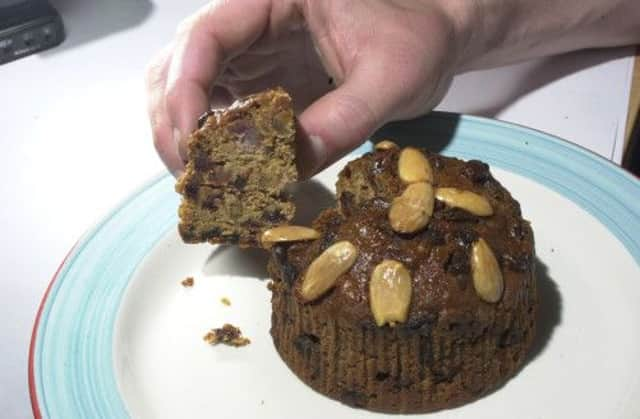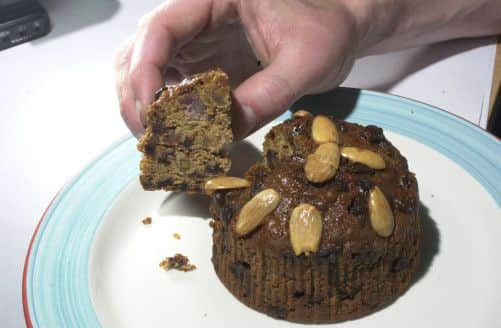Bid to grant Dundee cake protected status


It was revealed today that leading bakers in the City of Discovery have joined forces with the Scottish Government and experts at the city’s Abertay University to launch a campaign to secure official Protected Geographical Indication (PGI) status from the Commission to prevent the light fruit cake being produced and sold under the Dundee cake label anywhere else in Europe.
The Dundee cake was first mass produced by Dundee marmalade maker, Keiller’s, and traditionally contains candied peel, sultanas and almonds. But according to legend, the cake was first baked for Mary Queen of Scots in the 16th Century because she did not want any cherries in her fruit cake.
Advertisement
Hide AdThe campaign to secure European protection for the cake was announced by Richard Lochhead, Scotland’s Rural Affairs Secretary, when he visited the Dundee Flower and Food Festival today ahead of the start of Scottish Food and Drink Fortnight.


He said the Scottish Government and Scotland’s Rural College had already started working with producers and experts from Abertay University on an application for PGI protection under the EU’s Protected Food Name (PFN) scheme.
Mr Lochhead said: “Dundee is famous as a city of discoveries and we want the world to discover delicious, authentic Dundee Cake.
“We can trace its origins back hundreds of years to the kitchens of the marmalade inventor Janet Keiller, making it a thoroughly Dundonian delicacy which deserves European recognition for its unique characteristics and long association with this city.”
He continued: “Scotland is world-famous for our wonderful food and drink, and people want to know they are buying the real deal. Achieving PGI status for Dundee Cake will ensure that consumers at home and abroad have a one hundred per cent guarantee of the product’s authenticity.
“We already have Scottish foods, such as Stornoway Black Pudding and Scotch Beef, which are PGI protected and free from imitation. It guarantees the food’s provenance and supports local producers.
Advertisement
Hide Ad“The PFN scheme can benefit producers of brands synonymous with Scotland by providing them with recognition of their product and safeguarding it from imitation, and I would encourage them to look at taking this forward.”
As part of the application process food experts from Abertay have been working with leading city bakers Goodfellow and Steven, Clarks, the JM Bakery, and Baker Trade of Dundee to agree on a definitive recipe for Dundee Cake and a specification for Dundee cake to be included in the application to the Commission.
Advertisement
Hide AdMartin Goodfellow, of Goodfellow and Steven, said: “Although the Dundee Cake is a product that is known all over the world, it does not currently enjoy geographical protection and is produced in a number of locations to various quality levels. It is a significant part of our heritage and it is important that the cake is rightfully associated with the city in which it originated and its quality levels maintained.”
A Scottish Government spokesman explained: “The Scottish Government is in the process of finalising the application. The application for Dundee Cake PGI status outlines the raw materials and volumes that must be used to make Dundee Cake and specifies that the cake must be mixed, baked and decorated with almonds in the Dundee specific area.
“Once the application has been finalised, it will be subject to a national consultation. Once the consultation has been completed, the application will be forwarded the application to Defra, which is responsible for submitting applications from the UK to the European Commission. It takes, on average, two years for an application for receive approval, although new regulations introduced in 2013 aim to reduce this timescale to one year.”
He added: “Dundee Cake has an iconic appearance, in that the carefully laid-out pattern of whole, blanched almonds immediately distinguishes it from other fruit cakes. It is light and buttery containing sultanas, almonds, Amontillado sherry and candied orange peel. It is a fruit cake made by the creaming method, the mixture contains about 25 per cent more flour than normally expected and contains sugar with dried vine fruits, candied peel and chopped almonds, and the cake is flavoured with grated orange zest.
“An early version of a Dundee Cake was developed in the late 1700’s under the roof of Janet Keiller’s shop. Janet Keiller’s invention of a new type of Seville orange marmalade launched the family into large-scale commercial production. Around the mid 1800’s the factory began experimenting the idea of a special Keiller cake as a useful, non-seasonal item in the company’s production schedule. The recipe later became established as Keiller’s Dundee Cake.”
SEE ALSO: